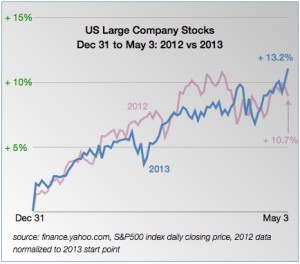US Stocks: What Could Go Wrong?
The US stock market is hovering near all-time highs, US large-company stocks have gained over 13% so far this year, and the “bull” market is over 4 years old–maybe getting long in the tooth. Did stocks go up too much too fast? Are US stock prices going to tumble?
The honest answer is: No one knows.
It’s quite possible that prices will decline, maybe precipitously, over the next few months. A “correction” is defined as a decline of 10%. It could happen for many reasons:
- investors start to worry about an overheated market, and want to “take profits” before an eventual decline
- an international incident triggers a sell-off: Middle-East tensions, North Korea, a country not-on-the-radar experiences turmoil (remember Cyprus and Mali?)
- a few key economic reports suddenly turn down
- the US government can’t agree on a debt-ceiling increase, or causes some other self-inflicted wound
- trading volume in the summer is often lower (we’re spending for vacations and investors are on vacation) which means less liquidity and more susceptibility to price declines
There’s an old Wall Street adage: “Sell in May and go away.”
For comparison, this chart (right) shows the year-to-date stock performance of the 500 largest US companies (the S&P 500), comparing 2013 to the same period in 2012. There are clear similarities between last year and this year.
Take Action?We do know that over long periods active investors who try to time market ups and downs do not beat investors who stick to their long-term strategy.
Why?
Here’s one way to look at it. When you try to time the market, you have to make two correct decisions: when to sell, and when to buy. Two correct decisions in a row.
Let’s say you’re really lucky at those decisions and have a track record of being right 60% of the time on each decision. (Recall that a very good baseball batter gets a hit 30% of the time.) To make two consecutive correct decisions with a probability of 0.6 (60%) for each decision, your overall probability of success is 0.6 x 0.6 = 0.36. That’s 36%. You’ll be right 36% of the time for both decisions together, or wrong 64%. That doesn’t sound like a winning strategy.
So, yes, something could go wrong and we could see a rapid decline in the US market. But if you have a long-term strategy in place that reflects your risk tolerance (in up and down markets) history tells us to sit tight. The exception would be if gains in US stocks have unbalanced your portfolio and triggered the threshold for rebalancing back to your long-term strategy allocations. That is part of implementing a long-term strategy, not market timing.
So sticking to your strategy may be the best approach. It’s not a guarantee, but it seems to be the best we have.
Disclosure: This article is general investment information, not investment advice for a particular individual. Investing involves risk of loss. Past performance is no guarantee of future returns. You cannot invest in an index such as the S&P500.
